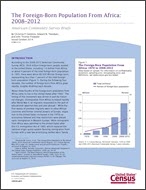Out of Africa: Recent Growth of the African Foreign-Born Population
Out of Africa: Recent Growth of the African Foreign-Born Population
When someone says the word “immigrant,” many people likely picture Europeans moving through Ellis Island during the late 1800s and early 1900s. Others think of a more recent time — especially after 1980 — when most immigrants arrived from countries in Latin America, such as Mexico, and, to a lesser extent, Asia. However, it may be surprising to learn that recent data show that the African foreign-born population is one of the fastest growing immigrant groups in the United States.
The African-born population has experienced rapid growth over the last 40 years, approximately doubling in size each decade since 1970. Between 1990 and 2000, the African-born population grew by over 140 percent, from 364,000 to 881,000, according to decennial census statistics. It nearly doubled again by 2012, reaching over 1.7 million, according to the American Community Survey.
Although the growth of the African foreign-born over the past decade was rapid, this population still represents only 4 percent of the 40.8 million foreign-born and less than 1 percent of the 313.9 million residents of the United States.
The foreign-born from Africa remain fewer in number than immigrants from other regions of the world as well. For example, in 2012 there were 21.3 million foreign-born from Latin America and the Caribbean, accounting for over half (52 percent) of all foreign-born and about 7 percent of the total population. The Asian foreign-born represented over one-fourth (29 percent) of the total foreign-born population and about 4 percent of the U.S. population.
A notable characteristic of the foreign-born population from Africa is the relatively high proportion that recently arrived in the United States. More than two out of five (43 percent) African-born immigrants in America arrived between 2003 and 2012 (see figure). This high proportion of recent arrivals is not typical of all immigrants, as about one-quarter (26 percent) of the total foreign-born population entered during the same 10-year period. The proportion of African-born who entered from 2003 to 2012 was higher than all other regions, including Asia (32 percent) and Latin America and the Caribbean (24 percent). Of the 746,000 foreign-born from Africa who entered the country between 2003 and 2012, about half were from Ethiopia, Nigeria, Egypt, Ghana and Kenya. The origin countries with the highest proportion of their total populations arriving after 2003 (about half for each) included Ethiopia, Kenya and Somalia.
The foreign-born population from Africa is a small but rapidly growing segment of immigrants, many of whom arrived in this country relatively recently. This population’s cultural diversity and other unique qualities, such as high educational achievement (41 percent of African-born immigrants had a bachelor’s degree or higher educational attainment in 2012, compared with 28 percent of the overall foreign-born), promise to add to the diverse American landscape.
For more information on the African foreign-born in the United States, see the new report released today The Foreign-Born Population from Africa: 2008-2012.




